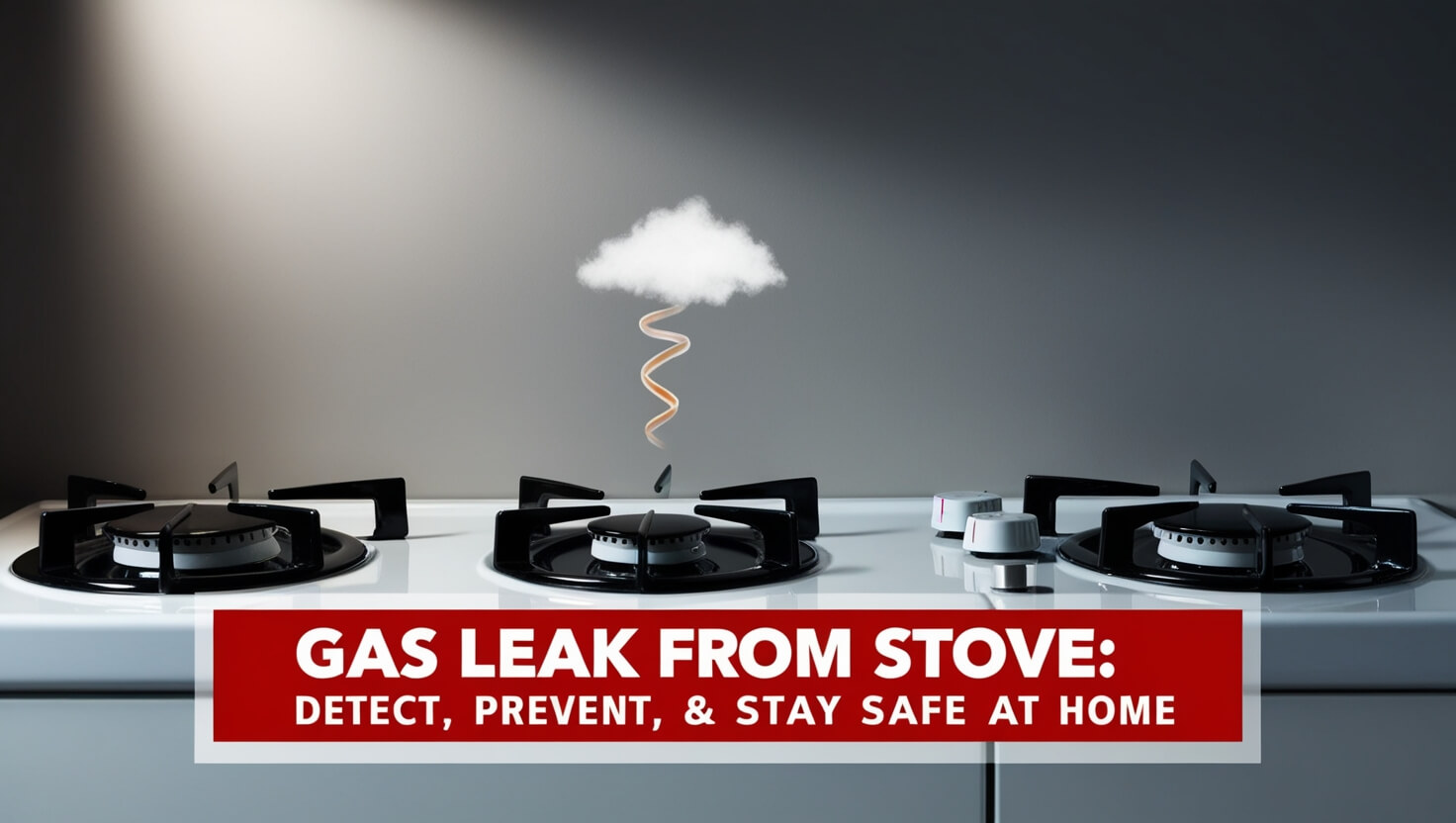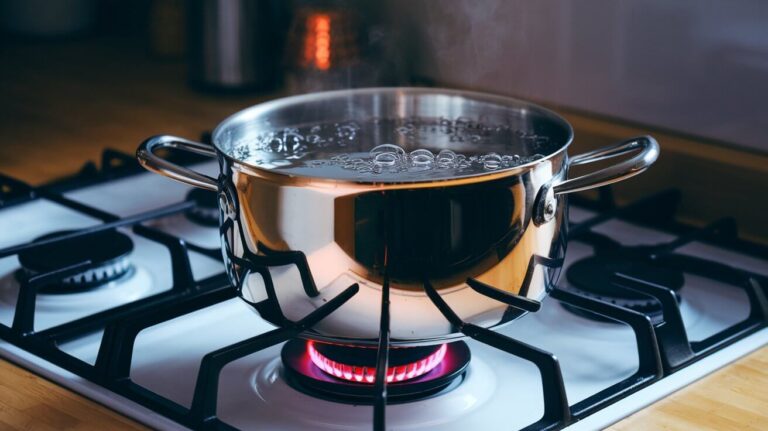
A gas leak from your stove can be dangerous, but quick detection and proper response can keep you safe. Gas stoves are popular for their precise temperature control and instant heat, but they come with risks. This guide covers everything you need to know about gas leaks from stoves, including how to spot them, what to do if you suspect one, and how to prevent them.
Understanding Gas Stoves and Their Potential Risks
Gas stoves use natural gas or propane to create flames for cooking. While they’re generally safe, leaks can happen. Let’s look at how these appliances work and why leaks occur.
How gas stoves work
Gas stoves connect to your home’s gas supply. When you turn a knob, it opens a valve, releasing gas to the burner. A spark ignites the gas, creating a flame. It’s simple, but several parts can wear out or malfunction.
Common causes of gas leaks in stoves
Gas leaks often stem from:
- Loose connections
- Worn-out seals or gaskets
- Damage to gas lines
- Faulty valves or regulators
- Improper installation
Even small issues can lead to leaks over time. That’s why regular checks are crucial.
Signs of a Gas Leak from Your Stove
Knowing the signs of a gas leak can save lives. Here’s what to watch (and smell) for:
Unusual odors: The telltale rotten egg smell
Natural gas is odorless, but gas companies add a chemical called mercaptan to give it a distinct smell. If you notice a rotten egg odor near your stove, it could be a gas leak.
Visual clues: Discolored flames and pilot lights
Healthy gas flames are blue. If you see yellow or orange flames, it might indicate a problem. Also, check pilot lights – they should burn steadily and blue.
Auditory warnings: Hissing or whistling sounds
Gas escaping from a leak can make a hissing or whistling noise. If you hear unexplained sounds around your stove, investigate further.
Physical symptoms: Health effects of gas exposure
Gas leaks can cause:
- Headaches
- Dizziness
- Nausea
- Fatigue
- Difficulty breathing
If you experience these symptoms at home but feel better outside, it could be a gas leak.
Detecting a Gas Leak: DIY Methods and Professional Tools
You can check for gas leaks at home, but professional tools offer more accuracy. Here are some methods:
The soap bubble test: A simple home check
Mix dish soap and water in a spray bottle. Spray the solution on gas connections and watch for bubbles. If you see bubbles forming, there’s likely a leak.
Using gas leak detectors: Types and effectiveness
Home gas detectors come in two main types:
- Catalytic sensors: They “burn” small amounts of gas to detect leaks.
- Infrared sensors: These use light to detect gas molecules.
Both can be effective, but they require proper use and maintenance.
When to call in the professionals
If you’re unsure about doing checks yourself or if you’ve found signs of a leak, call a professional. Gas companies and certified technicians have specialized equipment to detect even small leaks accurately.
Immediate Actions to Take When You Suspect a Gas Leak
If you think your stove is leaking gas, act fast. Here’s what to do:
Safety first: Evacuation and ventilation
- Get everyone out of the house immediately.
- Don’t use any electrical devices, including light switches or phones.
- If safe, open windows and doors to ventilate the area.
Turning off the gas supply: Location of shut-off valves
Know where your gas shut-off valve is. It’s usually near the gas meter. Turn it clockwise to shut off the gas. If you can’t find it or aren’t sure how to do this safely, leave it to the professionals.
Contacting emergency services and your gas company
Once you’re safely outside, call 911 and your gas company. Use a cell phone or a neighbor’s phone to avoid potential sparks inside your home.
Preventing Gas Leaks in Your Kitchen
Prevention is key when it comes to gas leaks. Here’s how to keep your stove safe:
Regular maintenance of your gas stove
Clean your stove regularly and check for any visible damage. Have a professional inspect it annually to catch potential issues early.
Proper installation and connection techniques
Always have a certified professional install or move your gas stove. They’ll ensure proper connections and follow safety codes.
Replacing old or worn components
Don’t wait for parts to fail. Replace worn seals, hoses, or valves promptly. It’s cheaper and safer than dealing with a leak.
The Role of Carbon Monoxide Detectors in Gas Leak Safety
Carbon monoxide (CO) is a byproduct of burning gas. It’s odorless and deadly. Here’s how CO detectors help:
How CO detectors complement gas leak detection
While gas detectors smell for gas, CO detectors measure this dangerous gas in the air. They’re your second line of defense against gas-related dangers.
Proper placement and maintenance of CO detectors
Install CO detectors on every level of your home, especially near sleeping areas. Test them monthly and replace batteries yearly or as needed.
Long-term Health Effects of Gas Exposure
Gas leaks aren’t just an immediate danger. Long-term exposure can have serious health impacts.
Chronic symptoms from prolonged low-level exposure
Even small leaks can cause:
- Persistent headaches
- Memory problems
- Mood changes
- Ongoing fatigue
Severe health risks from major gas leaks
Large leaks or prolonged exposure can lead to:
- Oxygen deprivation
- Brain damage
- Organ failure
- Death
These risks underscore the importance of prompt detection and response to gas leaks.
Gas Leak Myths and Misconceptions
Let’s clear up some common misunderstandings about gas leaks:
Debunking common misunderstandings about gas leaks
Myth: You can always smell a gas leak. Fact: While gas companies add a smell, some people can’t detect it. Rely on multiple signs, not just odor.
Myth: Gas leaks always cause big explosions. Fact: Many leaks are small and don’t lead to explosions, but they’re still dangerous.
Separating fact from fiction in gas leak detection
Myth: Cats and dogs can always detect gas leaks. Fact: While pets may react to gas smells, don’t rely on them for detection. Use proper tools and your senses.
Myth: Gas leak detectors are foolproof. Fact: Detectors can fail or give false readings. Regular maintenance and multiple detection methods are best.
Legal and Insurance Considerations for Gas Leak Incidents
Gas leaks can have legal and financial implications. Here’s what you should know:
Landlord and tenant responsibilities
Landlords must provide safe living conditions, including properly maintained gas appliances. Tenants should report suspected leaks immediately and allow access for inspections and repairs.
Insurance coverage for gas leak damages
Check your homeowner’s or renter’s insurance policy. Many cover damage from gas leaks, but prevention is always better than dealing with aftermath.
Alternatives to Gas Stoves: Weighing Your Options
If you’re concerned about gas leaks, you might consider other cooking options:
Electric and induction stoves: Pros and cons
Electric stoves eliminate gas leak risks but may cost more to operate. Induction stoves are energy-efficient and safe but require special cookware.
Making the switch: What to consider
Think about:
- Installation costs
- Energy prices in your area
- Your cooking style and preferences
- Long-term safety and maintenance
Conclusion: Staying Safe with Your Gas Stove
Gas stoves offer great cooking experiences, but they require attention to safety. Regular maintenance, proper use, and quick response to potential leaks are key. By understanding the risks and taking preventive measures, you can enjoy your gas stove with peace of mind.
Remember, if you ever suspect a gas leak from your stove:
- Leave the area immediately
- Don’t use any electrical devices
- Call emergency services and your gas company from a safe location
Stay alert, stay informed, and stay safe in your kitchen.






